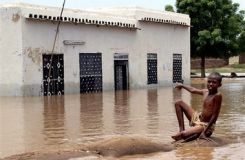Nile floods raise spectre of disease in Sudan
Sept 1, 2006 (KHARTOUM) — Heavy flooding in Sudan has left around 30,000 households facing the spectre of malaria, diarrhoea and other potentially deadly diseases, according to a warning from the United Nations’ aid office.
 Most of northern, central and eastern Sudan has been affected after torrential rain downstream in Ethiopia drove floodwaters up the Blue Nile, said Elisabeth Byrs, spokeswoman for the UN Office for the Coordination of Humanitarian Affairs.
Most of northern, central and eastern Sudan has been affected after torrential rain downstream in Ethiopia drove floodwaters up the Blue Nile, said Elisabeth Byrs, spokeswoman for the UN Office for the Coordination of Humanitarian Affairs.
“The enormous amount of stagnant water makes flood victims highly vulnerable to malaria, diarrhoea and respiratory infections,” Byrs told journalists.
She did not provide a figure for the individuals affected, and cautioned that the number of 30,000 households was an initial estimate.
“The number of fatalities is difficult to assess for the moment. Displacements have occurred in the most affected areas,” she added.
In the hard-hit state of Sennar, which is around 250 kilometres (155 miles) south of the capital Khartoum, homeless flood victims urgently need around 2,500 tents as well as 10,000 mosquito nets to ward off a feared malaria outbreak, said Byrs.
The International Federation of Red Cross and Red Crescent Societies said it had launched an initial emergency appeal of 600,000 Swiss francs (488,000 dollars, 381,000 euros) for Sudan’s flood victims.
Last week, authorities in Ethiopia said the flooding of the Blue Nile, — the worst in a generation — had claimed more than 600 lives and left tens of thousands of people homeless.
The Blue Nile has its source in the Ethiopian highlands, and joins the White Nile, which flows north from the Great Lakes, at Khartoum.
(AFP/ST)
